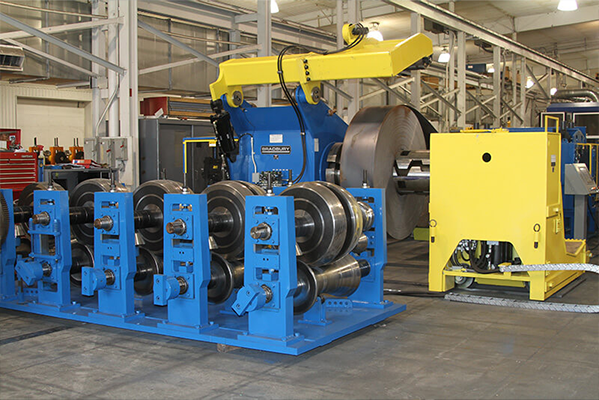Navigation Menu
Contact Us
- Email:
- info@wxavatar.com
- Address:
- Yurong Village, Yuqi Street, Huishan District, Wuxi, China.
Release Date:Mar 31, 2025 Visit:54 Source:Roll Forming Machine Factory
The hazards associated with a thick gauge roll forming production line can be categorized into several key areas, each with specific risks and potential consequences:
1. Mechanical Hazards
Equipment Stress and Failure: High forces required to shape thick metal can strain rollers, shafts, and frames, leading to mechanical failures (e.g., broken components, misalignment). Sudden breakdowns may cause projectiles or unexpected machine movements.
Pinch Points and Entanglement: Rollers and feed mechanisms pose entanglement risks for limbs, clothing, or tools, especially during threading or jamming incidents.
2. Human Factors
Crush Injuries: Heavy machinery parts (e.g., hydraulic systems, moving rollers) can cause severe injuries if safety guards are bypassed or interlocks fail.
Noise Exposure: Loud noise from metal deformation and machinery operation may result in permanent hearing loss without proper hearing protection.
Ergonomic Strain: Repetitive motions, heavy manual handling, or awkward postures during material guidance/alignment can lead to musculoskeletal disorders.
3. Material Handling Risks
Heavy Loads: Moving thick metal coils/sheets with cranes or forklifts risks crushing injuries if loads are dropped or improperly secured.
Sharp Edges: Cut or formed metal edges can cause lacerations during handling, trimming, or packaging.

4. Thermal and Frictional Hazards
Heat Generation: Friction between rollers and thick metal may produce excessive heat, leading to burns or material/machine degradation. Hot surfaces require insulation or cooling systems.
Fire Risks: Sparks from cutting/forming or flammable lubricants could ignite fires, especially near electrical systems.
5. Electrical and Control System Hazards
Electric Shock: High-voltage motors and control systems pose shock risks if wiring is damaged or grounding is inadequate.
Control Failures: Software/mechanical malfunctions (e.g., unintended starts, speed surges) due to programming errors or sensor issues.
6. Chemical and Particulate Exposure
Lubricants/Coolants: Skin contact with chemicals may cause irritation; spills create slip hazards.
Metal Dust/Particulates: Inhalation of airborne particles during cutting/drilling can lead to respiratory issues without proper ventilation or PPE.
7. Maintenance and Setup Risks
Lockout/Tagout (LOTO) Failures: Inadequate isolation during maintenance may result in unexpected machine activation.
Die/Roller Changes: Heavy tooling handling risks crushing injuries or strains during setup.
8. Environmental and Procedural Factors
Poor Housekeeping: Cluttered workspaces or slippery floors increase trip/fall risks.
Inadequate Training: Untrained operators may bypass safety protocols, increasing accident likelihood.
Emergency Preparedness: Lack of clear evacuation routes or fire suppression systems exacerbates incident severity.
9. Vibration and Tooling Risks
Hand-Arm Vibration Syndrome: Prolonged use of vibrating handheld tools for adjustments.

10. Complexity and Alignment Issues
Misalignment/Jamming: Incorrect roller setup for thick gauges may cause material jams, requiring hazardous manual intervention.
Mitigation Strategies (Brief):
Implement robust guarding, LOTO procedures, and regular equipment inspections.
Provide PPE (gloves, hearing protection, respirators) and ergonomic aids.
Ensure proper training, ventilation, and housekeeping.
Use automated material handling to reduce manual risks.
Install heat management and fire detection systems.
By addressing these hazards through engineering controls, administrative measures, and PPE, risks can be significantly reduced in a thick gauge roll forming environment.